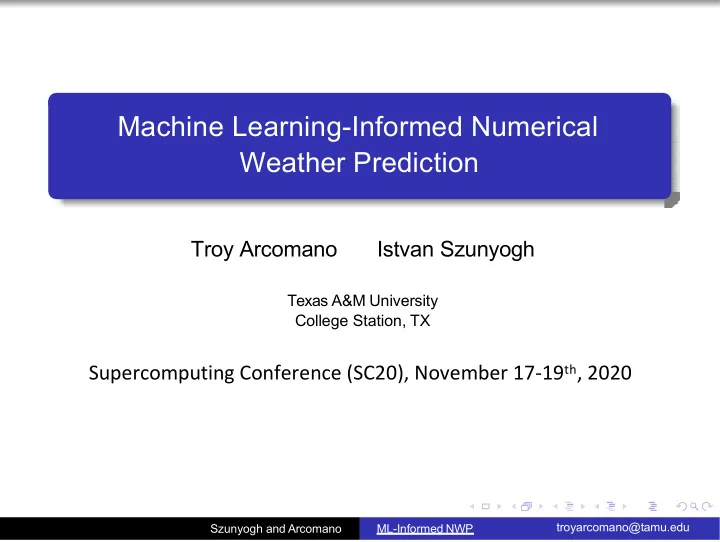

Machine Learning-Informed Numerical Weather Prediction Troy Arcomano Istvan Szunyogh Texas A&M University College Station, TX Supercomputing Conference (SC20), November 17-19 th , 2020 troyarcomano@tamu.edu Szunyogh and Arcomano ML-Informed NWP
General Approach The modeling approach is based on combining (Pathak et al. 2018b and Wikner et al. 2020) a numerical weather prediction (NWP) model and a computationally highly efficient machine learning (ML) algorithm to obtain a hybrid weather prediction (HWP) model that provides more accurate predictions than either component The ML model component uses a parallel (Pathak et al. 2018a) reservoir computing (Jaeger 2001, Maas et al. 2002, Lukoševicius and Jaeger 2009) approach Our goal is to prove the concept by building a low-resolution, global, HWP model troyarcomano@tamu.edu Szunyogh and Arcomano ML-Informed NWP ML-Informed NWP
Reservoir Computing A ‘time step’ of the ML model is a composite function that predicts the physical state u ( t + ∆ t ) from the physical state u ( t ) u ( t ) Wu ( t ) , r ( t ) r ( t + ∆ t ) u ( t + ∆ t ) Input Layer Output Layer Reservoir ˆ v Input Layer: Maps the physical state u ( t ) into a much higher dimensional reservoir state Wu ( t ) ( W is typically the matrix of a random projection) Reservoir: A high-dimensional dynamical system Output Layer: Reads out the physical state u ( t + ∆ t ) from the reservoir state r ( t + ∆ t ) troyarcomano@tamu.edu Szunyogh and Arcomano ML-Informed NWP ML-Informed NWP
Computationally Efficient, Parallel Algorithm The global state vector u ( t ) is partitioned into L local state vectors: Local State Vector: Each local state vector is predicted independently (the linear regression problem is solved in parallel for the different local state vectors) Extended Local State Vector: Input layer operates on an extended local state vector, so information can propagate between the local regions troyarcomano@tamu.edu Szunyogh and Arcomano ML-Informed NWP ML-Informed NWP
SPEEDY • S implified P arameterizations, primitive E quation DY namics Version 42 of the International Centre for Theoretical Physics (ICTP) • (Molteni 2003, Kucharski et al 2006) • Equations : • Primitive equations • Simplified but modern parameterization • Resolution: • 8 vertical layers • T30 (~300km) • Been used to test and develop new numerical weather prediction and data assimilation techniques troyarcomano@tamu.edu Szunyogh and Arcomano ML-Informed NWP
Training • Observation-based data set of past states of the atmosphere, regridded to SPEEDY horizontal and vertical grid • Used the 5 prognostic variables for SPEEDY • Temperature • 2 components of the wind • Specific Humidity • Surface Pressure • 11 years of data from 1981- 1991 • 9.5 years for training • 7 months for validation troyarcomano@tamu.edu Szunyogh and Arcomano ML-Informed NWP
Computational Details • A distributed and parallel architecture • Each local region is trained independently in parallel • Currently assigning 1 core per local region • 1152 regions used to represent the globe • Dense and sparse linear algebra calculations are done using OpenMP threaded LAPACK, BLAS, and Sparse BLAS functions found in the Intel’s Math Kernel Library (MKL) • Parallel IO • Non-collective, parallel HDF5 reading and writing of data • Reading in 750 GB of data with 1152 processors takes 10 minutes • Real runtime for training over 10 years and making predictions using TAMU’s Ada cluster with 1152 cores and 2.8 Terabytes of total program memory is about 1 hour troyarcomano@tamu.edu Szunyogh and Arcomano ML-Informed NWP
Verification • Comparing 20 hybrid forecasts to the regridded observation-based data not used for the training • The 20 forecasts span from June 1990 to January 1991 • Forecast skill was compared to that of SPEEDY, persistence forecasts, and a reservoir computing based machine learning only model (trained using the same data as the hybrid) troyarcomano@tamu.edu Szunyogh and Arcomano ML-Informed NWP
Verification II A lower value of the root-mean-square error (RMSE) indicates a more accurate forecast troyarcomano@tamu.edu Szunyogh and Arcomano ML-Informed NWP
Conclusion We built a prototype model that employs reservoir • computing for ML-Informed numerical weather prediction (NWP) The hybrid system performs better than the numerical • model out to 24 hours for all forecast variables • Atmospheric moisture and temperatures out to at least day 3 Parallel IO can greatly improve runtime performance • Reservoir computing algorithm with a parallel architecture • allows for massively parallel training without a GPU , which is significantly faster than for a deep learning network troyarcomano@tamu.edu Szunyogh and Arcomano ML-Informed NWP
Recommend
More recommend